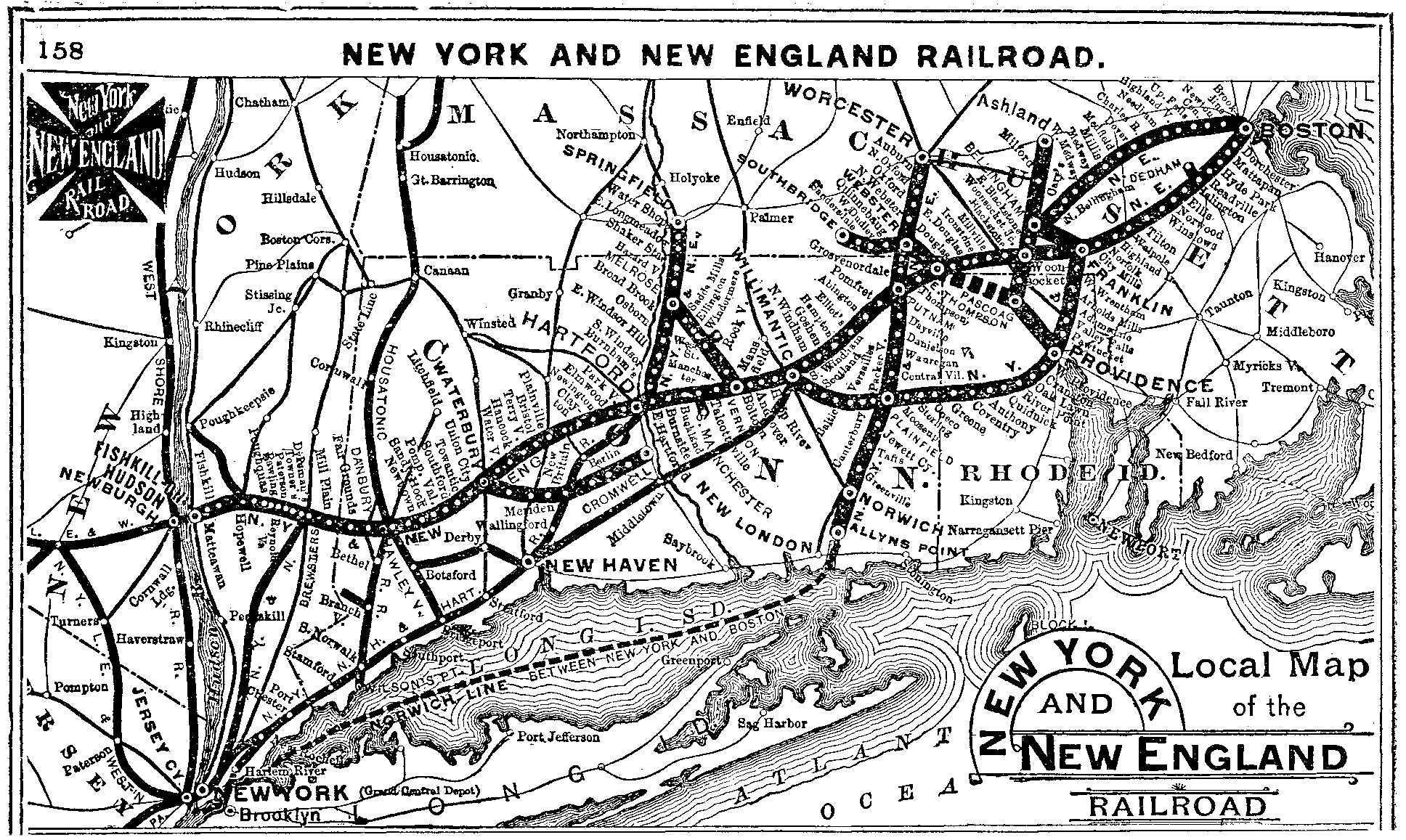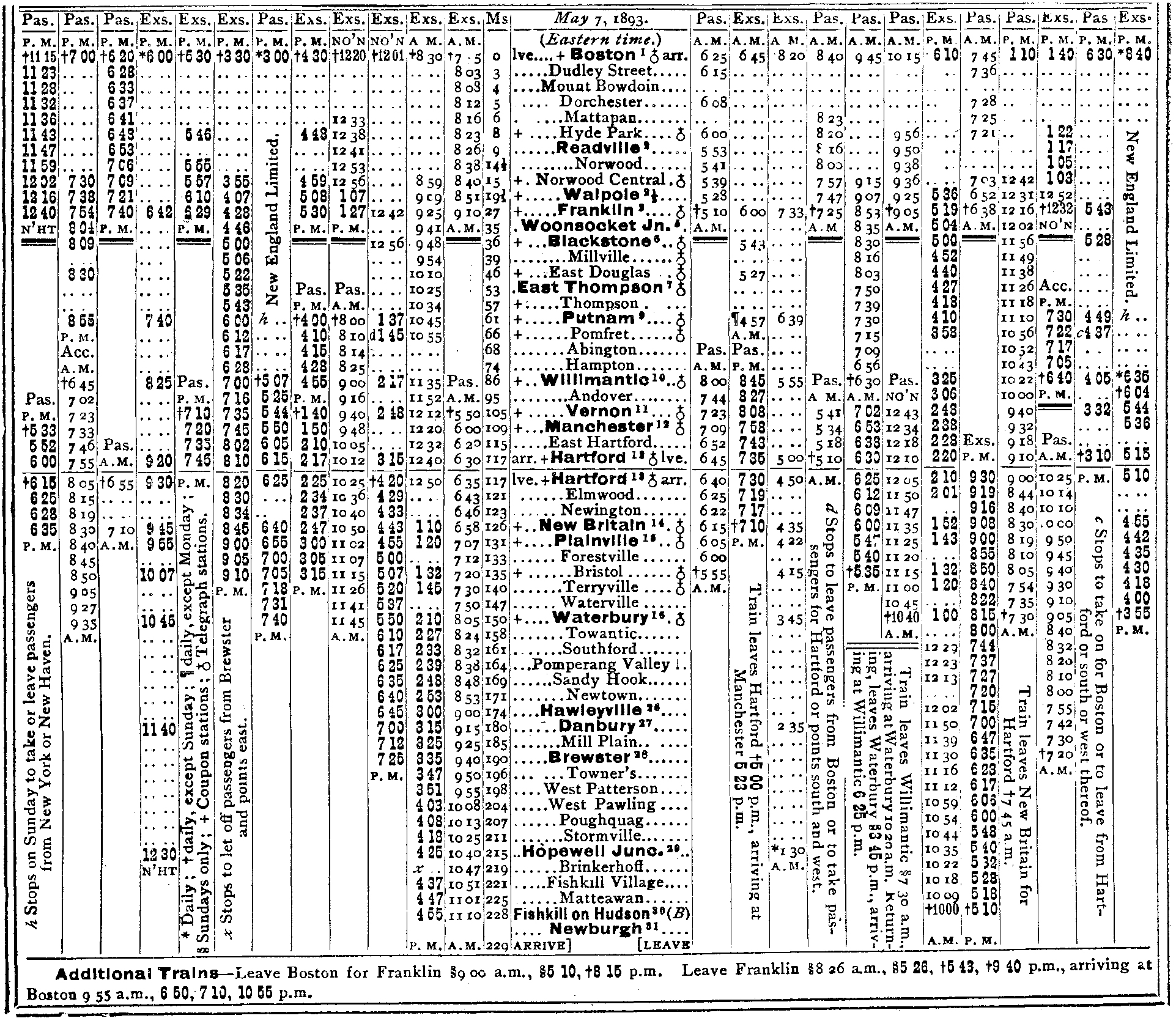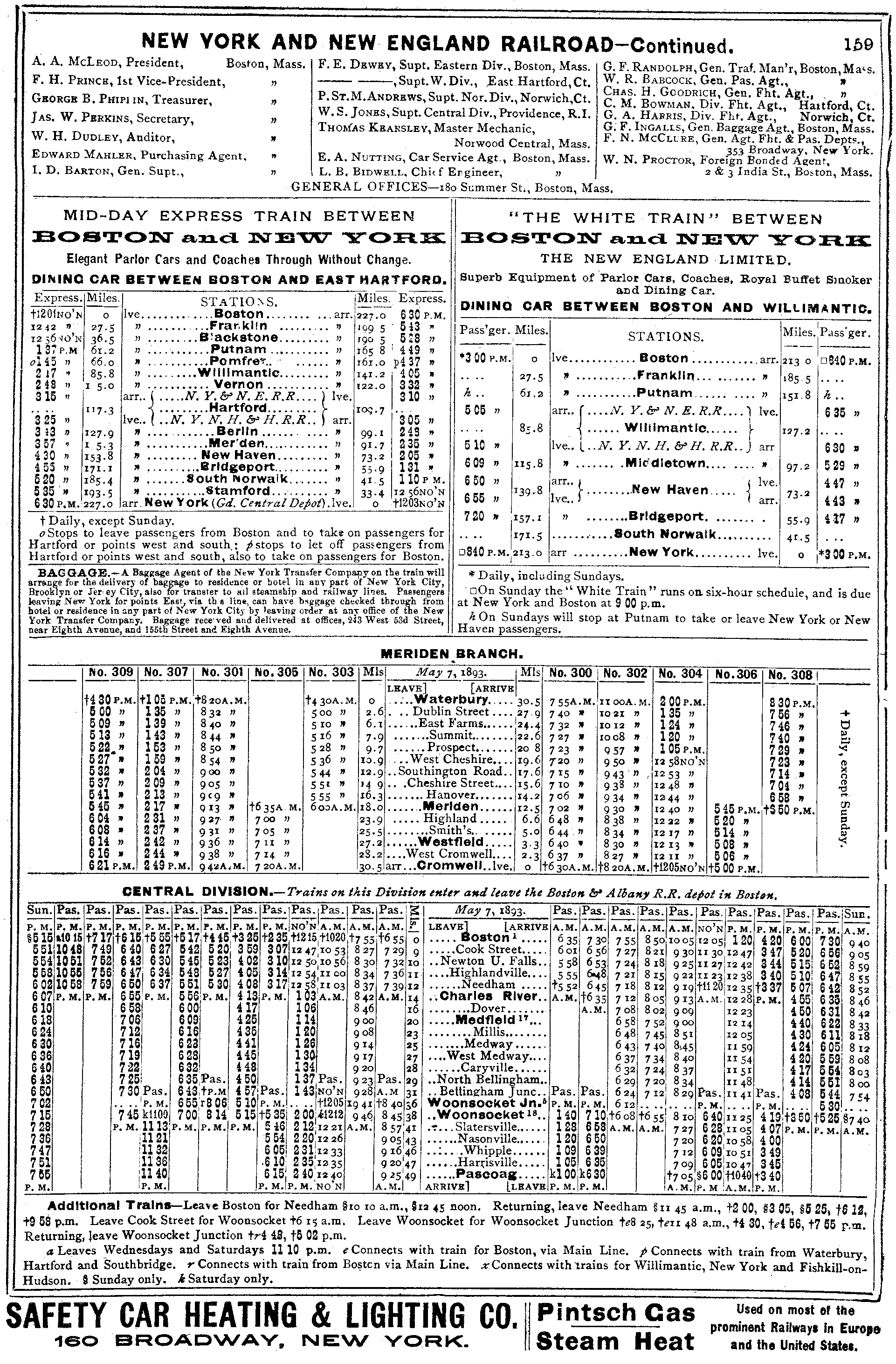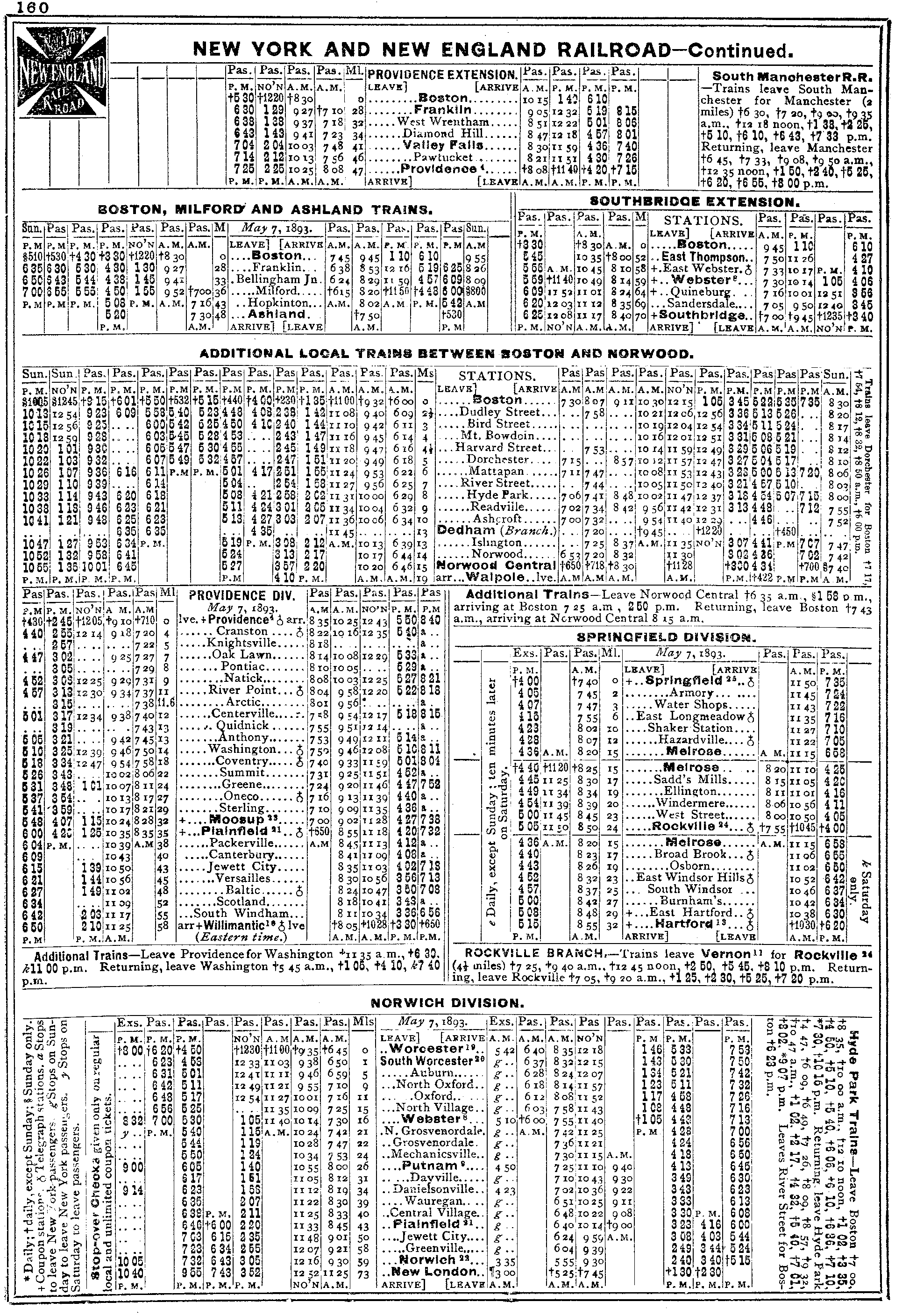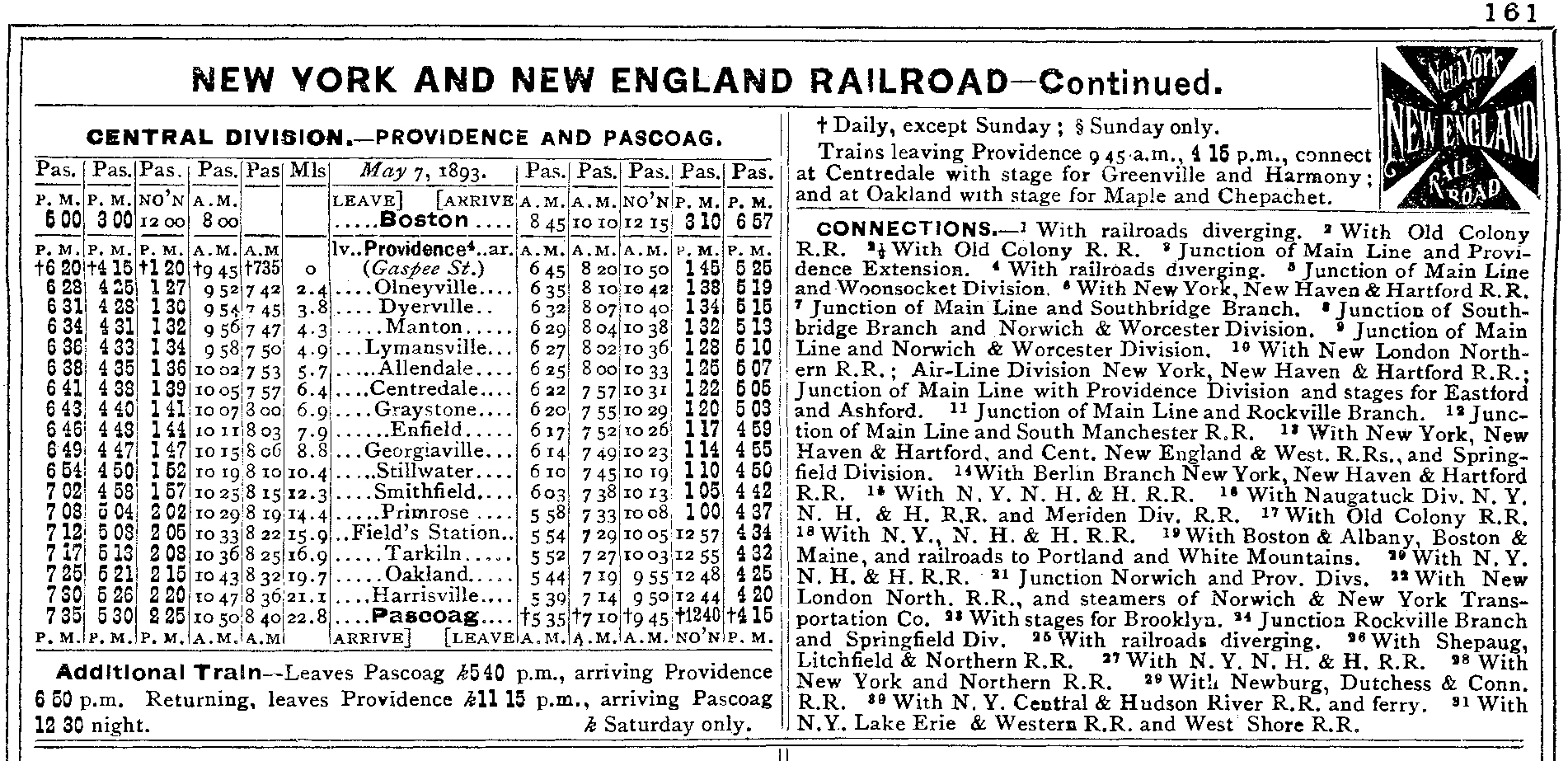New York & New England Railroad: Map, History, Timetables
Published: February 14, 2025
By: Adam Burns
The New York and New England Railroad (NY&NE) played a vital role in connecting two critical regions, fostering commerce, and shaping the economic landscape of New England and the broader Northeast.
At its peak the NY&NE linked southern New York State with key destinations in Hartford, Connecticut; Providence, Rhode Island; and Boston, Massachusetts. It bore the NY&NE name from 1873 until 1893. Before this period, it was the Boston, Hartford & Erie. This system itself had been formed through several smaller railroads, whose origins trace back to 1846.
Following a financial insolvency in 1893, the NY&NE underwent reorganization and briefly resumed operations as the New England Railroad. In 1898, it was leased to its rival, the New York, New Haven & Hartford Railroad.
Despite a network that peaked at 659.3 miles by the early 1890s, much of the historic NY&NE has since been abandoned. However, a few sections survive:
- A segment within Massachusetts has been integrated into the MBTA's Franklin/Foxboro Line, offering commuter rail access to Boston's South Station.
- Meanwhile, a section near East Hartford and Manchester, Connecticut, continues to handle freight via short line Connecticut Southern Railroad. Finally, some sections have also been converted into trails.
System Map (1893)
Early Beginnings
The formation of the NY&NE was emblematic of the fragmented state of early American railroading, where independent rail lines gradually coalesced into expansive networks. There were numerous small systems that formed the NY&NE either through merger or bankruptcy.
Providence - New York
The Providence, Rhode Island, to New York segment was constructed by three separate railroads. The first chartered was the New York & Hartford Railroad formed in May 1845 to link Hartford, Connecticut with the New York & Harlem Railroad at Brewster, New York.
Next was the Providence & Plainfield, chartered in June 1846, to connect Providence directly to the Rhode Island-Connecticut border. Following this, the Hartford & Providence Railroad was incorporated in May 1847, intended to continue westward to Hartford, Connecticut.
By 1849, the two Connecticut railroads merged to form the Hartford, Providence & Fishkill Railroad, with an amended charter permitting expansion beyond Brewster to Fishkill, New York, on the Hudson River.
This consolidation included the merger of the Rhode Island company in 1851. The initial segment of this expanded line, stretching from Hartford to Willimantic, commenced operations later that year.
Further extensions were completed reaching eastward to Providence in 1854 and westward to Waterbury by 1855. However, the HP&F faced financial difficulties, declaring bankruptcy on January 1, 1858. It was subsequently managed by trustees until 1863, when it was leased to the newly formed Boston, Hartford & Erie Railroad.
Boston - Providence
One of the earliest components along the Boston - Providence route was the Norfolk County Railroad (NCRR) chartered on April 24, 1847. The system commenced service from Dedham, Massachusetts - where it interchanged with the the Boston & Providence Railroad - to Walpole on April 23, 1849. Just a month later it had opened to Blackstone on May 16 where it joined the Providence & Worcester.
On May 1, 1849, the Southbridge & Blackstone Railroad was established to continue the line westward from Blackstone to Southbridge. The Midland Railroad was founded on May 2, 1850, to construct a new entry into Boston, merging it with the existing line south of Dedham. These two companies merged with the Norfolk County Railroad on December 12, 1853, to create the Boston & New York Central Railroad, which aimed to extend southwest through Connecticut to New York City.
The first section, Southbridge to Blackstone, Massachusetts, was incorporated in May 1853 as the East Thompson Railroad. The route further west from Blackstone to Mechanicsville, Connecticut, was built by the Norwich & Worcester Railroad and opened in 1853.
Consolidation and Expansion
The Boston, Hartford & Erie was the catalyst for the eventual unified network that became the New York & New England. It acquired the moribund Boston to Providence properties and intended to extend the railroad westward to Fishkill, New York where a car float would transport cargo to the Erie Railroad at Newburgh.
It swiftly secured a lease for the Hartford, Providence & Fishkill between Providence and Waterbury. By September of the same year, it had also acquired the former Boston & New York Central.
On February 11, 1867, the BH&E leased the NCRR. During that same year, a branch to Southbridge—part of the Southbridge and Blackstone’s original charter—was inaugurated. By 1869, the BH&E achieved a lease on the Norwich & Worcester Railroad, granting it a continuous route to Boston via the N&W extending from the Providence line at Plainfield northward to the historical NCRR at Mechanicsville.
In August 1872, the system further expanded with a direct connection from Willimantic on the line to Providence northeast to Mechanicsville, opening service to Boston. By 1869, the BH&E had leased the Dutchess & Columbia, which was building a line through Dutchess County, New York.
In 1873, the New Haven, Middletown & Willimantic Railroad was leased, which provided a rail line to New Haven. However, the BH&E ultimately overextended its finances and following the Financial Panic that year and declared bankruptcy. It was subsequently reorganized as the New York & New England Railroad on April 17.
Timetables (1893)
Economic Impact and Regional Significance
The economic impact of the NY&NE cannot be overstated. By providing a direct rail link between New York City and Boston, the railroad facilitated unprecedented economic synergy between two of the most vital economic hubs in the Northeast.
For the communities along its path, the railroad was more than a transportation solution—it was a catalyst for economic transformation. Towns and cities serviced by the NY&NE experienced industrial growth as businesses capitalized on improved access to markets and resources. The proliferation of manufacturing, textiles, and other industries along the rail line testified to the railroad’s profound regional impact.
Additionally, the NY&NE provided crucial transport for New England’s agricultural products, connecting rural areas with urban markets. This connection not only supported local farmers but also contributed to a more robust, interconnected economy.
Final Growth and Bankruptcy
In 1881, the Newburgh, Dutchess & Connecticut Railroad expanded its route westward from Waterbury to Hopewell Junction. This included track rights over the ND&C to Beacon, along with a short line constructed by the NY&NE extending to the Hudson River at Beacon.
This configuration completed the primary rail lines from Boston and Providence to the Hudson River. At this juncture, a train ferry transported rail cars to the New York, Lake Erie & Western Railroad's (Erie) Newburgh Branch at Newburgh. In New York, sections of the track utilized the previously unused railbed of the failed Putnam and Dutchess Railroad.
The Poughkeepsie Bridge, inaugurated in 1888, provided a permanent crossing over the Hudson River at Poughkeepsie, north of Beacon’s NY&NE car float. The Central New England & Western Railroad, which owned the bridge, subsequently incorporated the Dutchess County Railroad in 1890, completing it in 1892 to forge a connection from the bridge to the NY&NE at Hopewell Junction.
Despite its successes, the railroad faced significant challenges throughout its history. Competition with other railroads was fierce, particularly with the larger New York, New Haven & Hartford. The NYNH&H posed a formidable rival, controlling more extensive, established routes and enjoying a superior financial position.
The struggle to maintain profitability was further exacerbated by financial difficulties, managerial challenges, and fluctuating economic conditions. The NY&NE's attempts to compete involved periodic expansions and strategies to improve service offerings, but these efforts often strained its financial resources.
The NY&NE declared bankruptcy on December 27, 1893 and was reorganized on August 26, 1895, as the New England Railroad. Subsequently, New Haven secured a 99-year lease on July 1, 1898. In 1908, the New England Railroad was formally folded into the New Haven.
Legacy
The history of the New York & New England Railroad is a testament to the transformative power of railroads in the 19th and early 20th centuries. From its initial formation through mergers and consolidation, to its eventual decline and absorption, the railroad encapsulates the challenges and triumphs of an era defined by industrialization and economic development.
Recent Articles
-
Oregon Railroad Museums: A Complete Guide
Apr 25, 25 03:11 PM
With its rich tapestry of scenic landscapes and profound historical significance, Oregon possesses several railroad museums that offer insights into the state’s transportation heritage. -
North Carolina Railroad Museums: A Complete Guide
Apr 25, 25 02:56 PM
Today, several museums in North Caorlina preserve its illustrious past, offering visitors a glimpse into the world of railroads with artifacts, model trains, and historic locomotives. -
New Jersey Railroad Museums: A Complete Guide
Apr 25, 25 11:48 AM
New Jersey offers a fascinating glimpse into its railroad legacy through its well-preserved museums found throughout the state.
